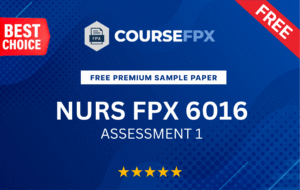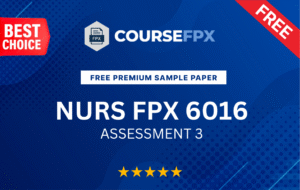NURS FPX 6016 Assessment 2
NURS FPX 6016 Assessment 2: Quality Improvement Initiative Evaluation
Individuals entering the medical career are human beings and they make mistakes. Unluckily, medical mistakes cannot be left out of the list of the most common causes, which result to the death of a patient. One of the five leading medical errors adversely affecting the patients is medication administration errors. The proposed study will explore and assess the successes and failures of quality improvement in the situation of pharmaceutical errors, evaluating quality improvement initiatives. Also, it analyses the two-person verification as a quality betterment program
Current QI initiative
As a result of the numerous monthly medical errors that have occurred over the years, we are now concerned with double-checking and replacing fire walls to stop surgical staff from hurting patients by giving them wrong medication as highlighted in NURS FPX 6016 Assessment 2. The most frequent instance of double checking is done at the time of administering the medicine as there are more errors that may arise during the period (Mcmullan et al., 2023). Errors that may arise during the administration procedure can be minimized using barcode medicine administration scanning that includes a double checking capability. Additionally, the nurse will use the five rights while giving medicine during this time. Another nurse will then confirm that everything is safe and appropriate to provide at this time. In order to prevent serious harm, the facility uses prescription pharmaceuticals, narcotic drips, insulin therapy drips, sedative drips, vesicant drugs, TPN/PPN, and blood transfusions.
A variation of additional verification is the two-person check, in which the another health professional checks that everything is in order and that it is safe to
deliver the medicine in the way that it is being provided while entering her login information into the EMR system. Distracters continue to be a contributing factor to errors and uncertainty about medicine labels, according to research on this procedure to prevent unfavorable outcomes and mistakes (Koyama et al., 2020). In various studies they conducted, they found that in many instances nurses only entered their credentials because they are busy, trust the other nurse, and they do not feel confident enough to report in case there is an error to the clinical supervisor, highlighting the need for analytics for program evaluation and quality improvement (Pfeiffer et al., 2020).
Determining Benchmarks & Outcome Measures
According to statistics, the number of medication errors is estimated to cause seven to nine thousand deaths every year in the United States alone, and more than forty billion dollars annually are spent by the country on individuals who have fallen victim to medication mistakes (Justinia et al., 2021). In ignoring the Leapfrog hospital safety grade on medication administration with the spring of 2024 it had a score of 100/100, the average was 93.42/100, and the lowest score is 25/100. Another proposal made by Leapfrog in the reporting was that in case of a barcode technology and its proper use there are much less medication errors than in the absence of the technology, since technology introduces obstacles to the nurse committing an error (Hospital Safety Grade, n.d).
NURS FPX 6016 Assessment 2: Inter professional Perspective
In recent researches there was evidence that when inter-professional teams are left to work with each other it can enhance the quality of care and better results as emphasized in NURS FPX 6016 Assessment 2. Nurses, doctors, clinical managers, psychologists, pharmacists, and healthcare personnel would all fall under this
category. It can avoid the emergence of errors in the numerous phases of medication process, such as prescription, transcription, the distribution of medication and administration, by optimizing an inter professional team collaboration. A slip up can be made in these stages at any stage and the work of the physician, pharmacist, and the nurse is to discover these slip up before the individual falls victim. A nurse is the final barrier to making mistakes (Irajpour, et al., 2019). Lack of time, a high workload, a lack of knowledge, weak leadership, and a lack of data are some of the obstacles that we may encounter while implementing inter-professional collaboration.
Talking with my coworkers about the two-person medication check taught me about the benefits and drawbacks of the process. According to the supervisor, it is an excellent method to ensure that mistakes are avoided while giving high-risk drugs and to increase patients’ general contentment. On the other hand, the bedside nurses thought it was a obstacle to providing the appropriate quality of care in the critical care unit but also a helpful strategy to prevent negative outcomes. Care may be delayed, particularly in cases where the patient is dangerously ill, as it may take some time for another nurse to check off and sign a medicine. Since they have individual patients to care for and may not have an opportunity to pause their work to check with someone else to see their medication, these kinds of hurdles are the reason why we find in multiple research studies that nurses only trust their fellow nurses or their own signature. It puts the care of one patient in a better position than the other and creates barriers in nurses, indicating the need for a quality improvement plan.
NURS FPX 6016 Assessment 2: Additional Indicators & Protocols
Since eleven years ago, Temecula Valley Hospital has been creating and reinventing the patient experience. In order to improve patient safety and care quality, they have made several reviews of their strategy, protocols, and standardized care, and
they have improved the way they are delivered. Possible markers and actions that might be used in conjunction with pharmacists and during monthly team conferences to ensure that all pharmaceutical prescriptions are promptly reconciled. To discharge these categories of patients, there has been a discussion of establishing an order set of these patients who are cardiac/stroke patients and who should automatically be inputted to discharge. The order list of a PGY2 inhibitor, brilinta, aspirin 81 mg are drugs that are significant to patients who have a new stent to maintain their arteries open and avoid clogging. The employees will be able to swiftly input the order set and allow the patient and their family members time to pick it up, in compliance with hospital practice that stipulates that individuals cannot leave the hospital until they have taken up their medication and handed it to the nursing team. Unlike handwritten scripts, ineffective communication, and inaccurate dosage and consumption instructions, this minimizes pharmaceutical errors by sending the medication to the pharmacy electronically. Additionally, it reduces the likelihood of misunderstandings and incorrect directives being given before the patient is released. Additionally, it would guarantee that the established orders are already in the EMR, reduce the clinicians’ burden, and free up more time to engage with the nursing staff to minimize medication mistakes at the institution, serving as a quality improvement plan example.
The nursing team would have access to a quiet medicine area so they can prevent mistakes as noted in NURS FPX 6016 Assessment 2. It would be safe to prepare and collect drugs in a calm, restricted-access setting where nurses wouldn’t be distracted by noise. Medication mistakes significantly decreased in institutions that provided their nursing staff with a safe haven where they could prepare and collect their drugs without interruptions, according to recent research (Berdot et al., 2021).
Implementing this effectively is hampered by limited accessibility, a lack of space, and the integration of the drug counter and pyxis with supplies.
References
Koyama, A. K., Maddox, C. S., Li, L., Bucknall, T., & Westbrook, J. I. (2020). Effectiveness of double checking to reduce medication administration errors: A systematic review. BMJ quality & safety, 29(7), 595–603. https://doi.org/10.1136/bmjqs-2019-009552
Temecula Valley Hospital. CA – Hospital Safety Grade. (n.d.). https://www.hospitalsafetygrade.org/h/temecula-valley hospital?findBy=hospital&hospital=Temecula%2BValley%2BHospital&rPos= &rSort=grade
Irajpour, A., Farzi, S., Saghaei, M., & Ravaghi, H. (2019). Effect of inter professional education of medication safety program on the medication error of physicians and nurses in the intensive care units. Journal of education and health promotion, 8, 196. https://doi.org/10.4103/jehp.jehp_200_19
McMullan, R. D., Urwin, R., Wiggins, M., & Westbrook, J. I. (2023). Are two-person checks more effective than one-person checks for safety critical tasks in high-consequence industries outside of healthcare? A systematic review. Applied ergonomics, 106, 103906. https://doi.org/10.1016/j.apergo.2022.103906
Pfeiffer, Y., Zimmermann, C., & Schwappach, D. L. B. (2020). What are we doing when we double check? BMJ quality & safety, 29(7), 536–540. https://doi.org/10.1136/bmjqs- 2019-009680
NURS FPX 6016 Assessment 2
Justinia, T., Qattan, W., Almenhali, A., Abo-Khatwa, A., Alharbi, O., & Alharbi, T. (2021). Medication errors and patient safety: Evaluation of physicians’ responses to medication-related alert overrides in clinical decision support systems. Acta informatica medica : AIM : Journal of the society for medical informatics of Bosnia & Herzegovina : casopis Drustva za medicinsku informatiku BiH, 29(4), 248–252. https://doi.org/10.5455/aim.2021.29.248-252
Berdot, S., Vilfaillot, A., Bezie, Y., Perrin, G., Berge, M., Corny, J., Thi, T. T., Depoisson, M., Guihaire, C., Valin, N., Decelle, C., Karras, A., Durieux, P., Lê, L. M., & Sabatier, B. (2021). Effectiveness of a ‘do not interrupt’ vest intervention to reduce medication errors during medication administration: A multi center cluster randomized controlled trial. BMC Nursing, 20(1). https://doi.org/10.1186/s12912-021-00671-7



